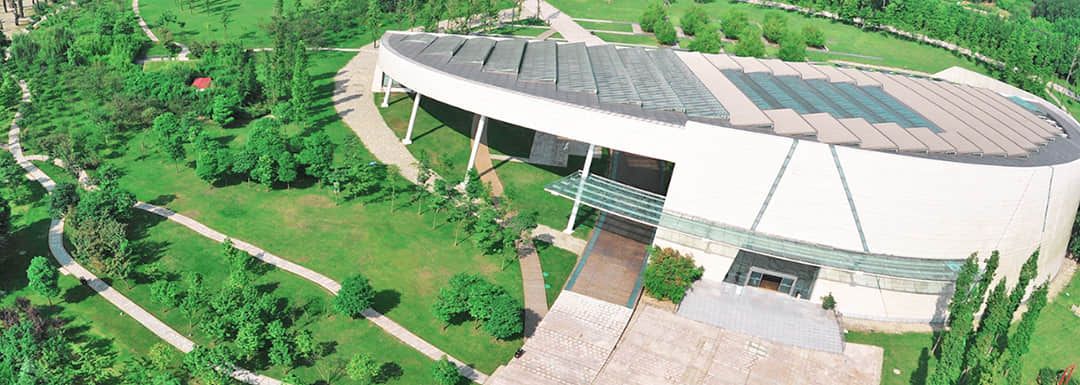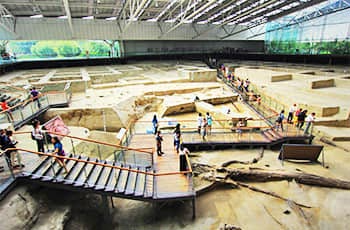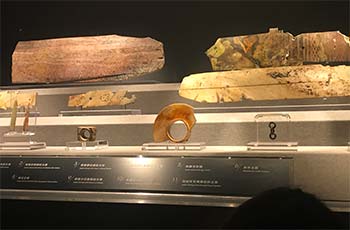Jinsha Site Museum

‘Shu’ is the ancient name for the Sichuan culture. The Jinsha Site Museum is located in the northwest of Chengdu City. It is a museum built on the original site of the Jinsha Site, a tremendous archaeological find of the ancient Shu civilization. It is listed in the National Grand Heritage Protection List. The museum is open to the public for the purpose of protecting, displaying and studying the Jinsha site and the ancient Shu civilization. It shows the most ancient remains ever found in China, that also have the longest duration, the best preservation, and the most abundant rituals.
- Chinese name: 金沙遗址博物馆 Jīn Shā Yí Zhǐ Bó Wù Gǔan
- Constructed in: 2004
- Duration: 3-4 hours
- Entrance fee: RMB 80 per person; 20 RMB per person for 4D cinema; Tickets for the musical "Jinsha", Class B, RMB 180; Class A, RMB 280; Special ticket, RMB 380 and VIP ticket, RMB 580. (On May 18th, "International Museum Day", the Museum is open to visitors for free)
- Opening hours: closed on every Monday:
In the peak season (May 1-October 31), 8:00 to 20:00; the ticket booth closes at 19:00
In the off season (November 1 - April 30), 8:00-18:30; the ticket booth closes at 17:30 - Address: No. 2, Jinsha Site Road, Qingyang District, Chengdu City, Sichuan Province, China
- Best time to visit: all year around
- How to get there:
Take the bus No. 5, No. 79, No. 83, No. 111, No. 123, No. 147 or No. 163 and get off at the North Qingyang Avenue Station or take the bus No. 7 and get off at the Jinsha Site Road Intersection
Highlights of Jinsha Site Museum
The Jinsha site is the first major archaeological discovery in China in the 21st century. It reproduces the glory of the ancient Shu Kingdom and the history of Chengdu's city construction which was modified from 2300 years ago to about 3,000 years ago. The museum is divided into the Relics Hall and the Exhibition Hall, as their square and round shapes represent separately the sky and the earth in the ancient concept. The Relics Hall is the excavation site, and the Exhibition Hall is the platform for the ancient cultural relics. In this site that dates back to Shang Dynasty (where were discovered the oldest written records in China’s history ever) and Zhou Dynasty, abundant ivories, goldware and jade in the world have been excavated, towering over all the other excavation achievements of the relics from the same era in the world.
Relics Hall

The Relics Hall is located in the east of the Museum. It is the most important archaeological excavation site of the Jinsha Site. It is also the earliest place where cultural relics were discovered. The Relics Hall is an all-steel framed circular building with a construction area of 7,588 square meters, a height of 19 meters and a span of 63 meters. As 90% of the cultural relics of the Jinsha site are still to be unearthed at the excavation site, the huge space supported by 15 steel columns has provided maximum protection of the archaeological excavation site.
Exhibition Hall
The exhibition hall is a sloping square building with a construction area of 16,000 sq. m and an exhibition area of 5,000 square meters. The two-layer full steel framed structure consists of five exhibition zones. The Golden Sun Bird and other archaeological elements are used for the roof design.
Exquisite artifacts
 The artifacts of the museum
The artifacts of the museum There were over 300 gold pieces unearthed in the Jinsha Site, most of which are gold foil and gold pieces in the shapes of the Golden Sun Bird, frogs, cicadas as well as gold masks and golden caskets. The Golden Sun Bird is goldware from around the Shang and Zhou Dynasties. The circular shape has a thickness of 0.02 cm. The pattern is divided into two circles, one inner and one outer, by means of being hollowed out. The inner circle has 12 rotating gears shining in equidistant distribution. The outer pattern is four golden birds, and together the pattern indicates the twelve months and four seasons in a year.
The gold mask is a three-dimensional face mask with a solemn expression on its well-shaped face. The surface is polished, whereas the inside is rough. It would have been put on during a ritual or a sacrifice. In addition, there are still over a thousand bronzes, mainly avatars, heads of cattle, three-dimensional monsters, ornaments, etc. These small objects would have been used with other ritual objects in the past.
Drop us a line and we'll connect you with the top China expert in no time!